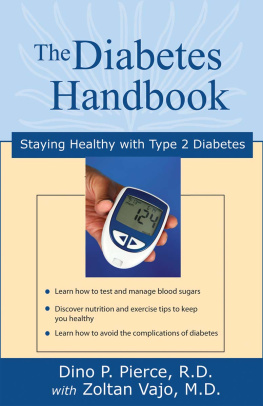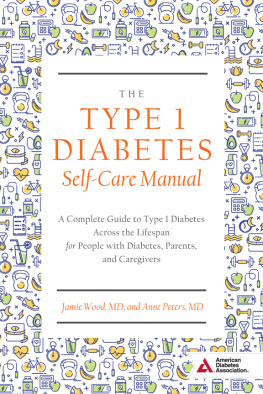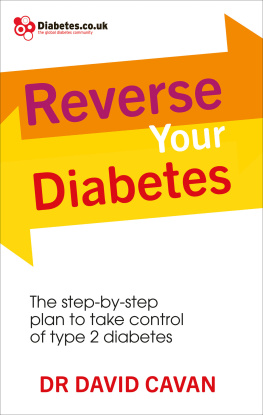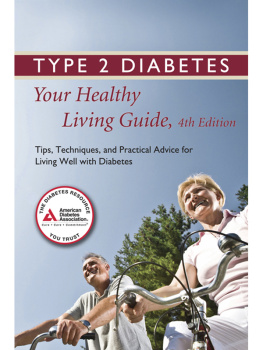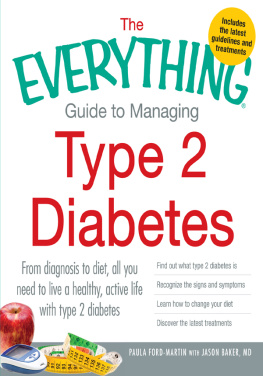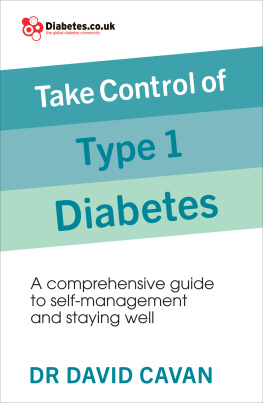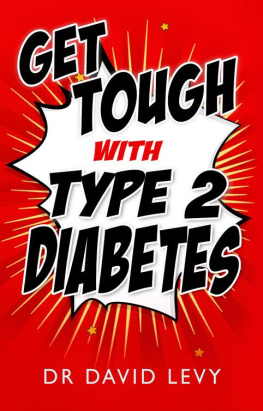
An Addicus Nonfiction Book
Copyright 2011 by Rod Colvin. All rights reserved. No part of this publication may be reproduced, stored in a retrieval system, or transmitted in any form or by any means, electronic, mechanical, photocopied, recorded, or otherwise, without the prior written permission of the publisher. For information, write Your Health Companion Books, Inc., P.O. Box 45327, Omaha, Nebraska 68145.
ISBN: 978-1-886039-64-3
Cover design by Jack Kusler
Illustrations by Jack Kusler
Typography by Linda Dageforde
This book is not intended to serve as a substitute for a physician. Nor is it the authors intent to give medical advice contrary to that of an attending physician.
Library of Congress Cataloging in Publication
Colvin, Rod
The type 2 diabetes handbook : six rules for staying healthy with type 2 diabetes / Rod Colvin ; with James T. Lane.
p. cm.
Includes index.
ISBN 978-1-886039-64-3 (alk. paper)
1. Non-insulin-dependent diabetesPopular works. I. Lane, James T. II. Title.
RC660.4.C654 2011
616.4624dc22
2010038447
Addicus Books, Inc.
P.O. Box 45327
Omaha, Nebraska 68145
www.AddicusBooks.com
Printed in the United States of America
10 9 8 7 6 5 4 3 2 1
Contents
Foreword
T ype 2 diabetes is an epidemic in the United States. According to the American Diabetes Association, the number of cases of type 2 diabetes in the United States has almost quadrupled in the past thirty yearsfrom 6 million cases in 1980 to 18 million today with an estimated 6 million whove not been diagnosed. The cost in terms of human suffering and healthcare dollars is staggering.
As an endocrinologist, I have treated diabetes patients for the past twenty years. I have seen the suffering this disease can bring. However, I also know that it is possible to prevent or significantly reduce this suffering. I work with other physicians, nurses, and diabetes educators to help patients understand type 2 diabetes so that they can avoid complications.
Diabetes is unlike other diseases in that you can make lifestyle changes to control it. As youll read in this book, these changes involve eating right, losing weight, exercising, monitoring glucose levels, and taking medications as directed. This book will serve as a helpful tool for making your life healthier and happier.
James T. Lane, M.D., Medical Director
The Nebraska Medical Center
Diabetes Center
Acknowledgments
I would like to thank James T. Lane, M.D., Medical Director of the Nebraska Medical Center Diabetes Center, for serving as the medical editor for this book. His guidance and expertise were invaluable.
I also wish to thank members of Dr. Lanes staff for the expertise they shared, including Beth Pfeffer, Director of Diabetes Services, Lisa Nichter, dietician, and Kristina Volkmer, exercise physiologist.
I thank Karen Abrams, Anne Steinhoff, and Alyson Meadows for their research and editorial support. I express my appreciation to Jack Kusler, who provided the illustrations for the book.
To wish to be well is part of becoming well.
Senca, Roman Philosopher
Rule 1
Learn the Basics about Type 2 Diabetes
T ype 2 diabetes is an epidemic in the United States. The American Diabetes Association estimates 18 million Americans have been diagnosed with the disease and another 6 million others have it, but have not been diagnosed.
Type 2 diabetes develops most often in adults over the age of forty, but can develop in young people, too. If not kept under control, diabetes can cause serious complications. People with type 2 diabetes are two to three times more likely to have a heart attack or stroke. Diabetes is also the most common cause of kidney failure and blindness in adults under age sixty. Other potential complications include nerve damage, which may lead to pain and numbness in the hands and feet, and damage to blood vessels, which may result in amputation of limbs. Nerve damage can also affect many other bodily functions.
Coping Emotionally
Its never easy to hear from your doctor that you have a chronic disease such as type 2 diabetes. Its not uncommon to feel depressed after being told you have diabetes, and depression may have a negative effect on your health. When youre depressed, you may not feel motivated to take the best care of yourself. Consequently, you may not eat right or take medications as directed. These actions can cause blood sugars to rise even higher.
If youre like many people, you may at first go into denial about having type 2 diabetes. You may tell yourself things such as This cant happen to me or My case will be differentI wont have problems like some other people do. After all, I dont really feel sick.
Denial is a common response to a diagnosis of diabetes. Perhaps initial denial allows our minds to accept the news more gradually. However, ongoing denial is a dangerous thing. It will prevent you from getting the care you need to manage the disease. Some people deny having the disease for years before taking action to control it; this lack of action over time significantly increases the risks for complications.
One way to break through denial is to talk with people you trust about having type 2 diabetes. Keeping it a secret feeds the denial. Discuss your thoughts and feelings openly. If you feel you would benefit from more emotional support, consider finding a therapist, a certified diabetes educator, or a support group. Once you accept the diagnosis, youll be better prepared to start a treatment plan.
Defining Type 2 Diabetes
Type 2 diabetes is a metabolic disorder caused by the combination of the bodys resistance to the effect of insulin (not using its own insulin efficiently) and the pancreas not producing enough insulin. As a result, there is an increase in the level of sugar, also known as glucose, in the blood. This causes a condition known as insulin resistance, which is at the root of type 2 diabetes. If you learn that you have high blood sugars, you may have been gradually becoming insulin resistant for several years.
In order to understand the concept of insulin resistance, lets review briefly how our food is digested and turned into energy. When food enters your body, it is broken down into small components, including glucose, an important sugar that comes from carbohydrates. Glucose is a major source of energy for the body. When you eat carbohydrates, your body detects a rise in glucose and signals the pancreas to produce insulin. Together, glucose and insulin enter the bloodstream. The insulin allows the glucose to enter the cells of the muscles and liver to be used for energy.

The pancreas is located behind the lower part of the stomach. Beta cells within the pancreas secrete insulin, which helps control carbohydrate metabolism.
If your body is not producing enough insulin, or if your body is not using the insulin efficiently, the glucose doesnt reach the cells. This causes a rise in glucose. Your body will counter with increased insulin production and secretion, which also causes an increase in the levels of insulin in the blood. There are multiple causes of insulin resistance.
Causes of Insulin Resistance
Obesity.
Next page
